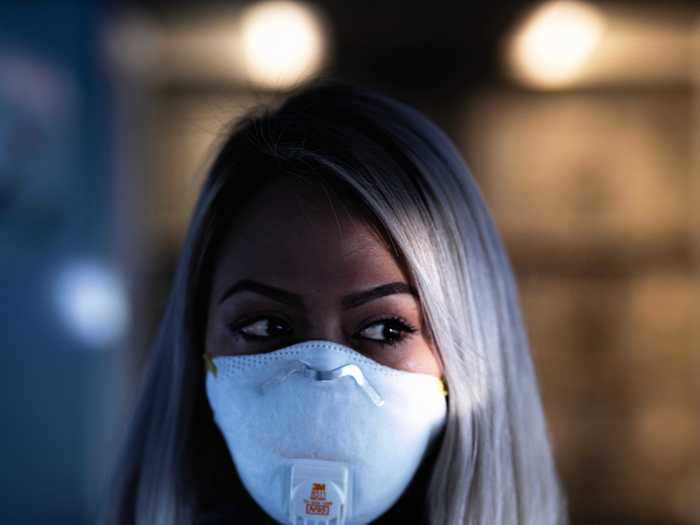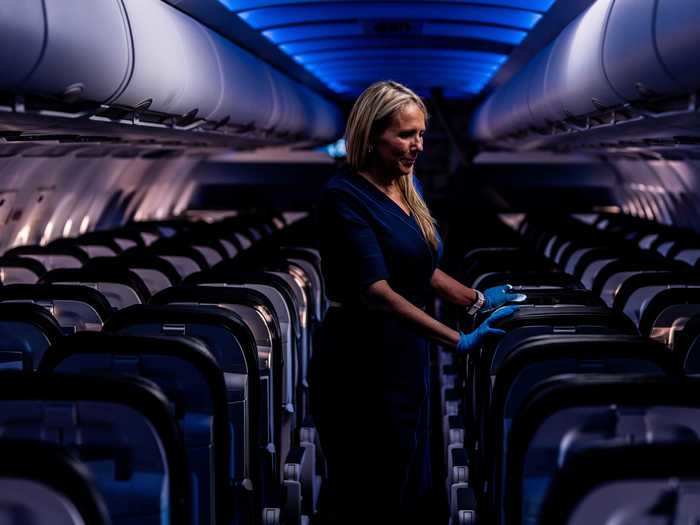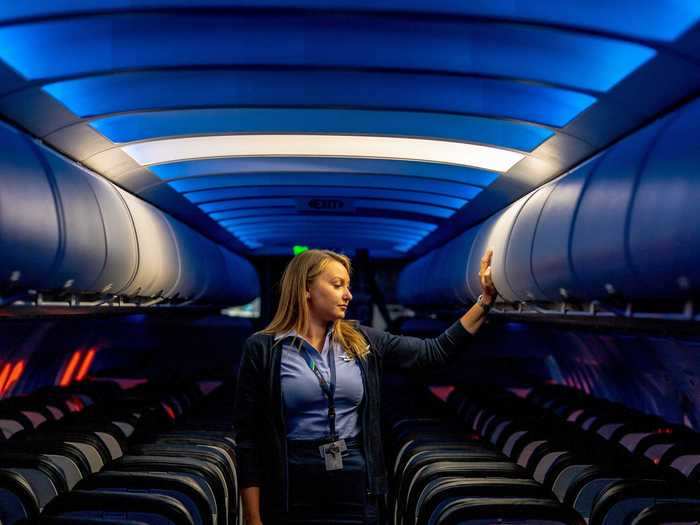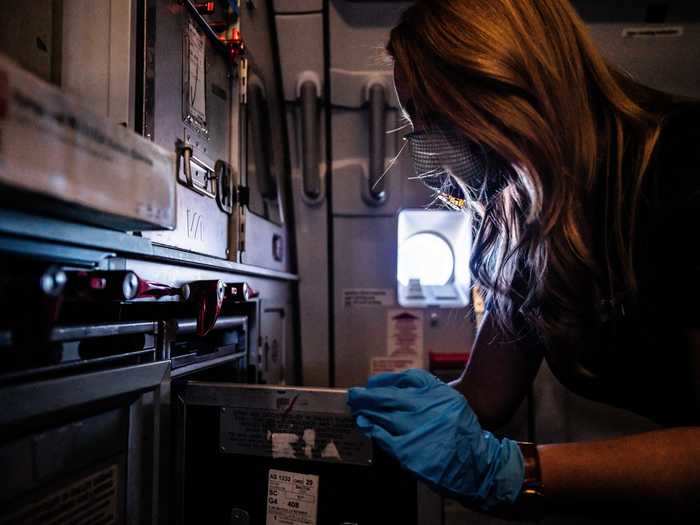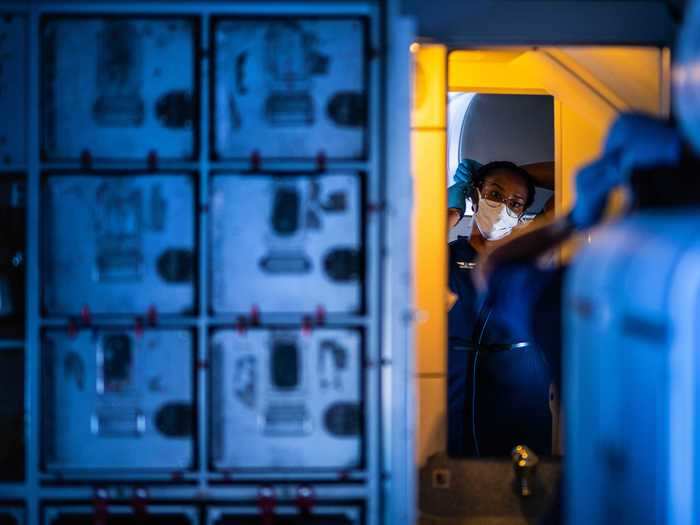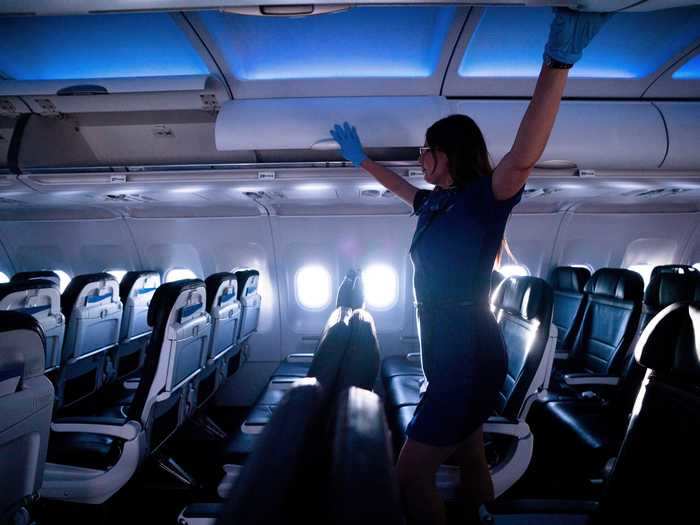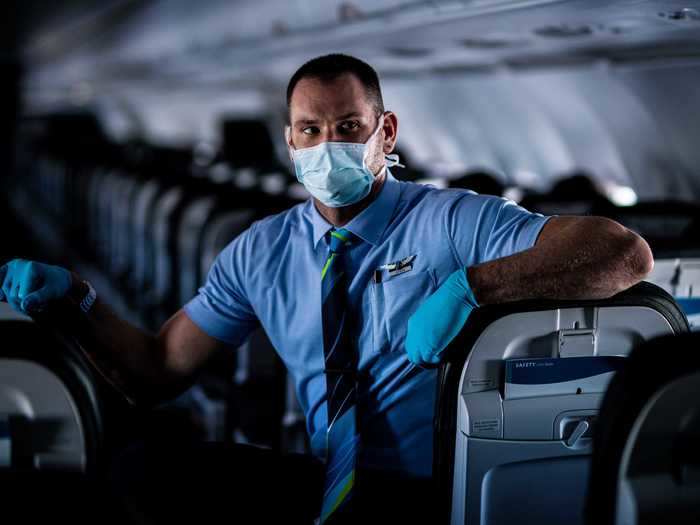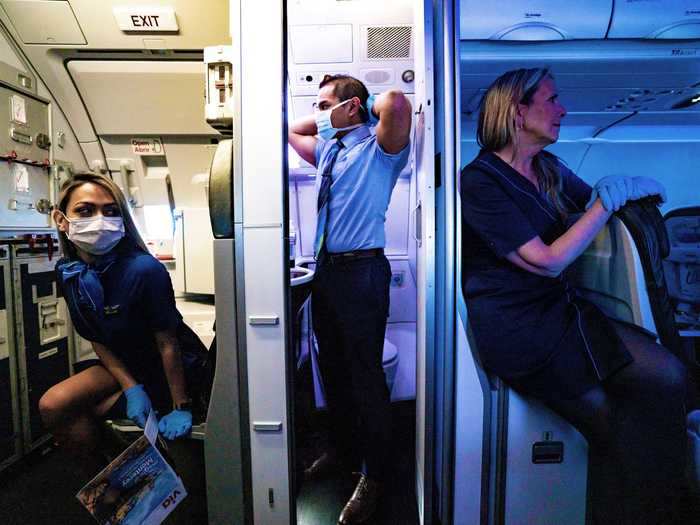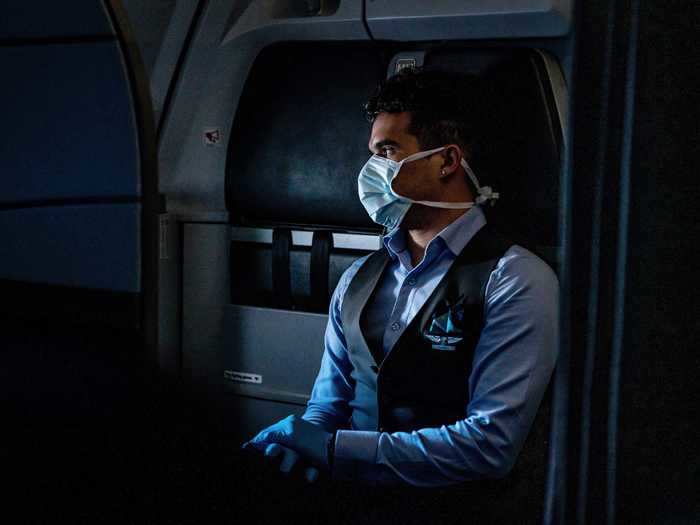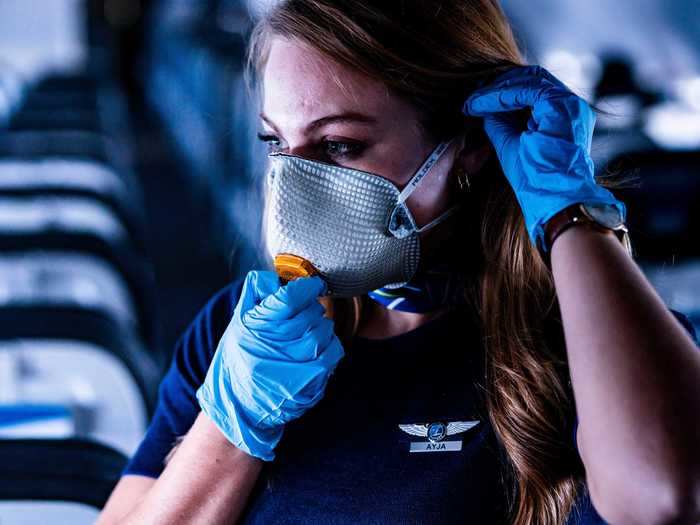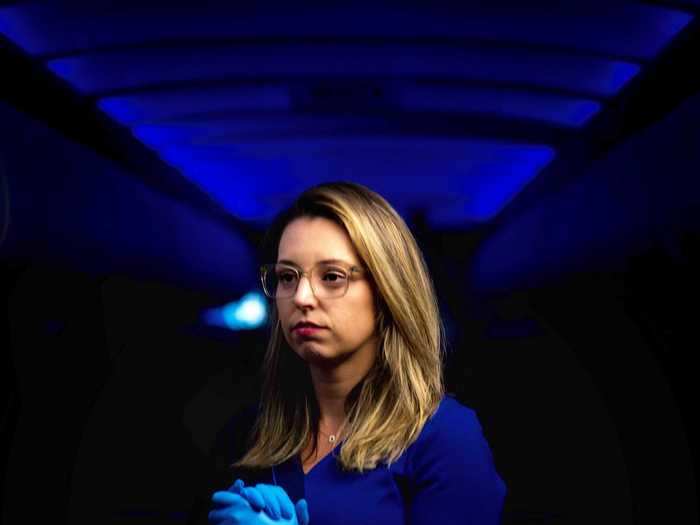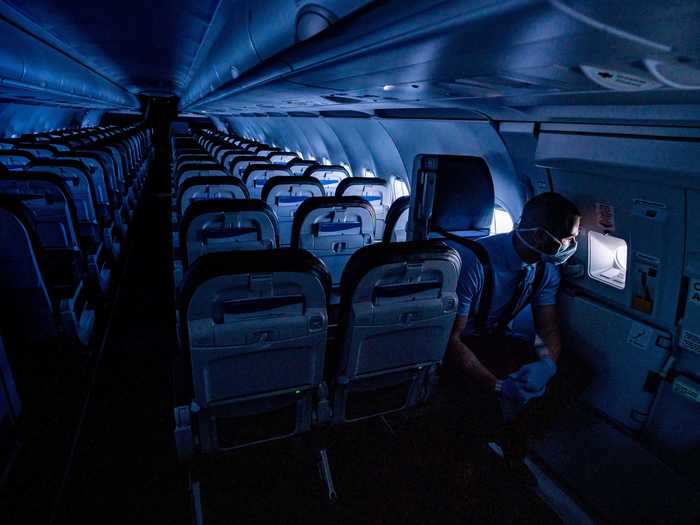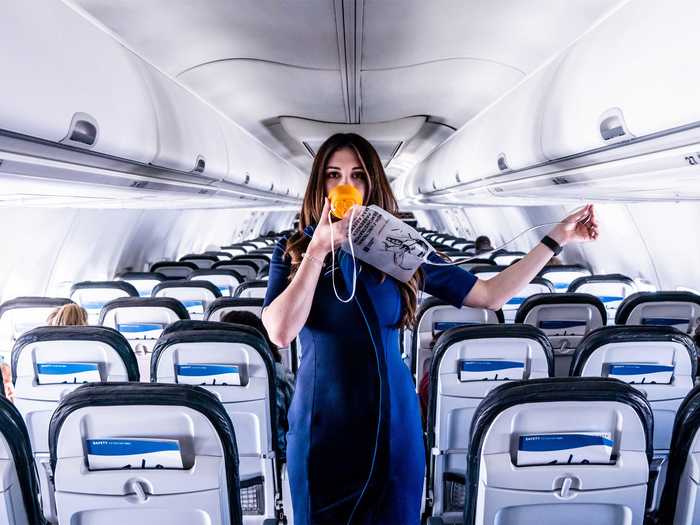A flight attendant ties a face mask.
Molly Choma- Molly Choma is a flight attendant for Alaska Airlines.
- As one of the remaining flight attendants still working, she's documenting her experience through photography.
- Choma told Insider that the flights feel "pensive and empty," which is the message she's trying to recreate in her images.
- Visit Insider's homepage for more stories.
Molly Choma still wears lipstick underneath her face mask when she works, simply because it makes her smile more.
As a flight attendant working during the pandemic, many of her passengers are in need of a smile. Her near-empty flights carry medical staff to hospitals and family members to loved ones.
Choma is one of the remaining flight attendants still working.
The coronavirus has drastically reduced flights. In the US alone, the number of travelers screened by the Transportation Security Administration has decreased by more than 96%, according to APM Research Lab. Worldwide, there were an estimated 40% fewer flights at the end of March compared to the previous year.
Choma brought her mom's Nikon camera to the airport 11 years ago. Now, the 33-year-old works as a flight attendant and photographer. During downtime on her flights, Choma captures images of her coworkers.
The Alaska Airlines flight attendant believes the photographs she's taking during the pandemic will help create archives of what life was like for her and her colleagues.
"The pattern of human resilience is amazing," she told Insider. "But it's really important to have these times on some sort of record. And to be appreciative when, eventually, the economy picks back up."
Read the original article on
Insider
"I know that someday people will be flying again," the flight attendant said.
Alaska Airlines flight attendants are provided face masks, Molly Choma told Insider.
Molly Choma
Choma said that every job and every worker is going through something he or she has never gone through before. The world will look different after this, but Choma believes people will continue to fly.
"When it's safe to do so, I'm excited for that day," she said.
For now, her focus is on the few people still flying.
While the feeling isn't necessarily sadness, Molly Choma hopes to convey a message of exhaustion in her photographs.
Molly Choma
"I'm just figuring out how to be there for people when you have nothing to give them except navigating them from point A to point B," Choma said.
She hopes that her passengers can feel a sense of peace when they step on the plane. If they're tired, she urges them to sleep. If they're quiet, she makes sure to stay silent.
She said she can feel the emotional weight many of them are bringing onto the plane.
"Maybe I can carry a little bit of that for them," she said.
Choma never thought she'd miss the full flights.
A flight attendant poses for a photograph on a dark plane.
Molly Choma
While the full flights once felt hectic and busy, it's a feeling Choma and many of her colleagues are missing.
And for flight attendants who aren't flying, it's a glance at what work currently looks like.
Molly Choma said all passengers come prepared for the flight. "They have masks; they have gloves; they sanitize the seats," she told Insider. "They're very aware of the potential consequences of traveling by air."
Molly Choma
While thousands of flight attendants have stopped flying, these pictures give a glimpse at what that work looks like today.
"I'm communicating to my colleagues what it's like here," she said. "And maybe even affirming that they made the right choice."
While the photos are heavy, Choma said taking them provides her coworkers with a distraction.
At first, the flight attendants were unsure of how to wear their masks.
Molly Choma
Photography allows her coworkers to take a break.
By shifting their focus on a photograph or recreating the scene, it helps "get your brain out of the 'what-if situations.'"
"It's the first time, that I've experienced, in the service industry, where you're like, 'Actually, I'm not OK,'" the flight attendant said.
A flight attendant closes the empty overhead bins.
Molly Choma
One result of the situation is that it's created a stronger support network, Choma explained.
New Facebook groups, text threads, and conversations have started to support one another.
Choma described the airline industry as "one big family." That's become even more apparent now.
"It's kind of opened the communication gates," she said.
A lot of flight attendants are handling the situation through humor, but Choma wanted to showcase something different.
Molly Choma's subjects are coworkers she's worked with for years.
Molly Choma
At first, Choma was worried about her photographs feeling intrusive.
Three flight attendants for Alaska Airlines.
Molly Choma
After chatting with coworkers, many were eager to help her create her vision.
During downtime before, during, or after a flight, Choma takes out her camera. She only photographs her consenting coworkers, never passengers.
Choma said she often tries to recreate the scenes she saw when the flight attendants were working.
The idea for the photo series sparked from a conversation with a friend.
Molly Choma is capturing the more pensive, harder sides of being a flight attendant during the pandemic, she said.
Molly Choma
Choma's friend urged her to start taking pictures of flights again.
Choma had previously documented Virgin Airlines when the company merged with Alaska Airlines.
Her photographs helped preserve Virgin Airlines' history.
"That was the first time in the airlines where I was trying to figure out how I felt about something," she said. "It was helpful to process that through photography."
While chatting with her friend about the coronavirus and its impact on aviation, Choma thought photography could help her process this situation.
Choma acknowledges the danger that comes with working in the middle of a pandemic, but flying has always been dangerous, she said.
A flight attendant readjusts her mask.
Molly Choma
Choma's mother was a flight attendant. From a young age, Choma recognized the inherent danger in being and working on planes.
Choma said she's come to terms with the risks. "I'm younger. I'm healthy. I don't have kids. I don't have a family or anyone that relies on me financially," she explained.
So Choma chooses to continue to fly.
She did add that there's a heightened awareness of the danger, but that "part of my job is to be alert at all times."
"It's an instinctive, guttural thing to keep flying," Choma said about her decision to keep working during the pandemic.
Molly Choma is pictured above. The photographer is usually behind the camera.
Molly Choma
Choma was on a plane nearly every day in March.
But now she's on standby while a majority of her scheduled flights get canceled.
"My decision to keep working is just based on the people I've seen flying," she told Insider.
Her interactions with passengers and their need to get from one place to another have helped her understand the essential role of flights.
"There are not that many flights anymore, but for the few flights that are left, it's really important for people who can and are willing to keep showing up to work," Choma said.
Her photographs evoke somber emotions. The flight attendant described her passengers stepping onto the plane and "holding the weight of the world."
This was one of the first photographs Molly Choma took in the series. It's still her favorite, she told Insider.
Molly Choma
While the planes might be emptier, the atmosphere feels heavier, Choma explained.
"There have always been essential travelers on the planes, but they're always cushioned by business and vacation travelers," she said.
Now that the nonessential travelers have vanished, the flights have a different feeling. That tone of pensiveness or exhaustion is conveyed through her photographs.
Molly Choma, an Alaska Airlines flight attendant and photographer, is capturing photos of her empty flights. "Part of it is me processing how I am emotionally dealing with the situation, and part of it was wanting to preserve these memories," she told Insider.
A flight attendant presents a safety demo to a nearly vacant plane.
Molly Choma
When Choma described her recent flights, words like "heavy," "surreal," and "weighted," floated throughout the conversation.
Choma's average flight has between eight and 12 people, and the passengers are often medical workers or people flying to say goodbye to loved ones.
Although Choma only photographs flight attendants, she said she tries to capture the feelings of her passengers through the images.
"I am trying to process what was going on, but do it in a way that would give these empty planes a voice," she told Insider.

